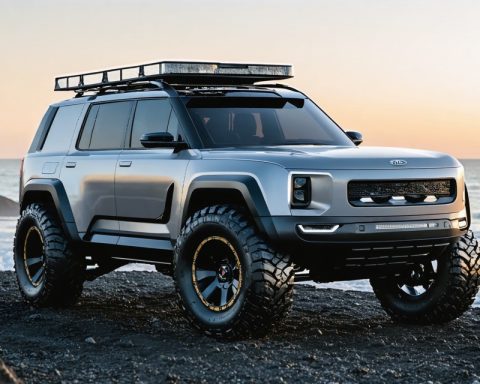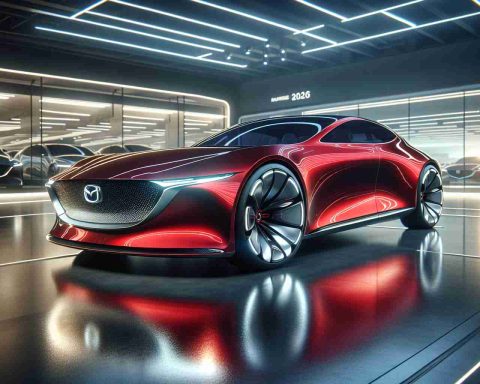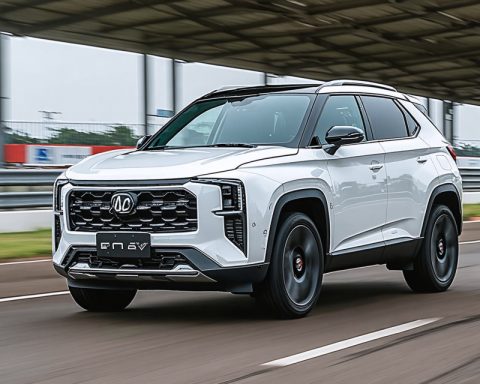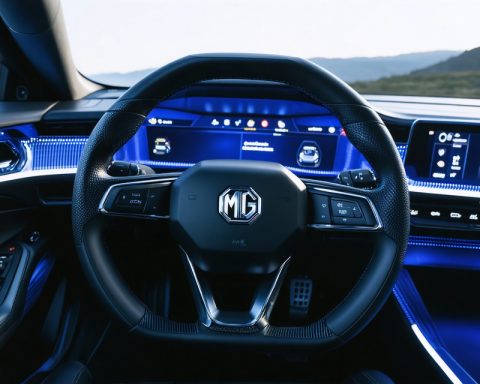- The Kia Niro EV has been phased out, giving way to the more affordable and advanced Kia EV3 in Australia.
- Priced at $47,600 plus on-road costs, the EV3 offers a cost-effective option for eco-conscious consumers.
- The Niro EV’s higher prices of $66,590 and $72,360 were less appealing compared to new models like the EV5 at $56,770 drive-away.
- Kia continues to support its hybrid model, with plans for a hybrid SUV like the Seltos hybrid expected around 2027.
- Kia’s transition underlines the importance of innovation and adapting to consumer demands in the automotive industry.
The bustling automotive landscape of Australia, once a prime battleground for Kia’s pioneering electric venture, has witnessed a seismic shift. The once-celebrated Kia Niro EV has quietly slipped into the annals of history, its existence eclipsed by the debut of Kia’s latest wunderkind: the EV3.
Picture this scene: A polished, modern showroom, gleaming with the presence of promising future models—it’s here that the Niro EV finds itself ousted by its own kin. The fringes of excitement buzz around the arrival of the EV3, a vehicle crafted with precision and priced to astound. At $47,600 plus on-road costs, the EV3 Air Standard Range beckons the environmentally conscious with a more economical allure, stealing the limelight from its older sibling.
The math is simple yet stark: while the entry-level Niro EV model demands a hefty $66,590, and its upscale counterpart climbs to $72,360, Kia’s new players, like the EV5 starting at $56,770 drive-away, resonate more with a consumer base eager for savings. The enticing price tags and fresh engineering of these newcomers pose a challenge the Niro EV could no longer surmount.
But Kia isn’t halting this progressive march; instead, it reallocates its vision. Although conceding the Niro EV to obsolescence, the hybrid variant remains—a testament to demands persisting for eco-conscious choices in compact sizes. As Kia Australia’s product planning chief recently illustrated, the Niro’s hybrid iteration will likely persist as a viable option until the impending Seltos hybrid emerges around 2027, potentially shutting the chapter on Niro’s saga altogether.
The journey of the Niro began in earnest back in May 2021, an ambitious endeavor that painted hopes for an electric future. With models ranging from purely electric back to hybrids, it served a destitute market thirsting for electrification options. Yet, a scant two years hence, its story ends due to an in-house rivalry, as 1455 Australian sales in 2024 couldn’t stave off the inevitable.
A key lesson emerges: The relentless pursuit of innovation and customer desires can sometimes render yesterday’s pioneers obsolete. The Niro EV, an initial beacon of Kia’s electric dreams, now gives way to a new era defined by the EV3’s affordability and advanced features. As we witness this new chapter unfold, it becomes clear that in the automotive realm, the only constant is change.
As the evanescent Niro EV fades into memory, its legacy—a harbinger of Kia’s electric evolution—serves as a poignant reminder of the relentless pace of progress and the ever-adaptive nature of consumer tastes.
The Rise of Kia’s EV3: Why the Affordable Electric Revolution is Here
Introduction
The automotive landscape has always been characterized by rapid shifts in consumer preferences and technological advancements. The recent transition from the Kia Niro EV to the more affordable and innovative EV3 in Australia exemplifies this phenomenon. In this dynamic market, Kia has recognized the need to adapt quickly, offering more value and cutting-edge features to meet the evolving demands of environmentally conscious consumers. Let’s delve deeper into this shift and explore the implications for the electric vehicle (EV) market, both in Australia and beyond.
Key Differences: Niro EV vs. EV3
Pricing and Affordability
One significant factor in the EV3’s rising prominence is its competitive pricing. The EV3 Air Standard Range’s starting price of $47,600 plus on-road costs makes it more accessible than the outgoing Niro EV, which was priced at $66,590 for the entry-level model. This pricing strategy aligns with Kia’s efforts to capture a larger share of the price-sensitive EV market, appealing to budget-conscious buyers seeking sustainable options.
Technology and Features
The EV3 is equipped with advanced technology to enhance the driving experience, with features that were once exclusive to higher-end models now becoming standard. This includes improved battery efficiency, state-of-the-art infotainment systems, and enhanced connectivity options. Such advancements underscore the technological leap the EV3 represents over the older Niro EV.
Industry Trends and Predictions
The EV Market’s Trajectory
The global EV market is experiencing exponential growth, driven by legislative policies, technological advancements, and shifting consumer preferences toward sustainability. According to industry forecasts, the demand for electric vehicles is expected to continue on an upward trajectory, with a projected compound annual growth rate (CAGR) of over 20% in the next decade.
The Future of Hybrid Models
While the Niro EV may no longer be part of Kia’s lineup, its hybrid variant continues to serve a niche market that values both electric and traditional combustion powertrains. The hybrid model is anticipated to remain in demand until more models like the Seltos hybrid become available by 2027. Kia’s continued commitment to hybrid technology signifies the industry’s broader shift toward versatile, low-emission vehicles.
Pros and Cons Overview
Pros of the EV3
– Affordability: The lower price point makes the EV3 a viable option for a broader consumer base.
– Innovative Features: Offers state-of-the-art technology typically found in higher-priced models.
– Environmental Impact: Contributes to reduced carbon emissions and aligns with sustainable practices.
Cons of the EV3
– Limited Range: Compared to some competitors, the standard range may not suffice for those needing longer travel distances without frequent charging.
– Market Competition: As the EV market expands, Kia faces increasing competition from other brands offering similar features.
Actionable Recommendations
For those considering an entry into the EV market, or looking to upgrade, here are a few tips:
– Evaluate Your Needs: Assess how often you drive and the distances you cover to ensure the EV3’s range meets your daily requirements.
– Consider Future Costs: Factor in potential savings on fuel and maintenance versus any initial higher purchasing cost.
– Explore Incentives: Investigate government incentives or rebates available for EV purchases, which can significantly offset initial costs.
– Research Charging Infrastructure: Familiarize yourself with available charging stations in your area to plan for convenient charging.
For more information on Kia’s latest models and technological advancements, visit the official Kia website.
Conclusion
The transition from the Kia Niro EV to the new EV3 marks an exciting development in the automotive industry. As consumers lean towards affordable yet advanced vehicles, companies like Kia are positioned to lead future EV advancements while meeting evolving market demands. In the ever-changing world of automotive innovation, staying informed and adaptable remains crucial for consumers and manufacturers alike.






















